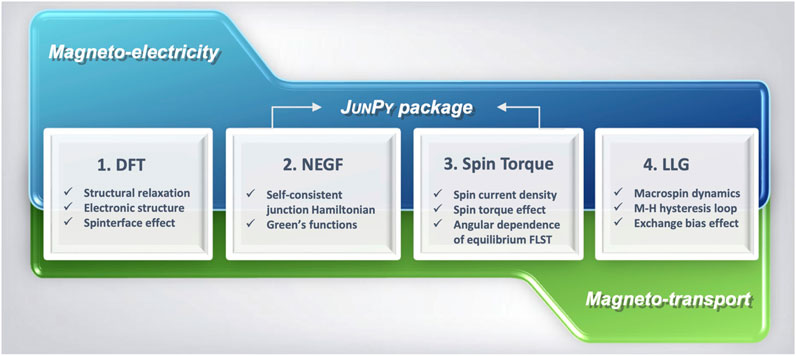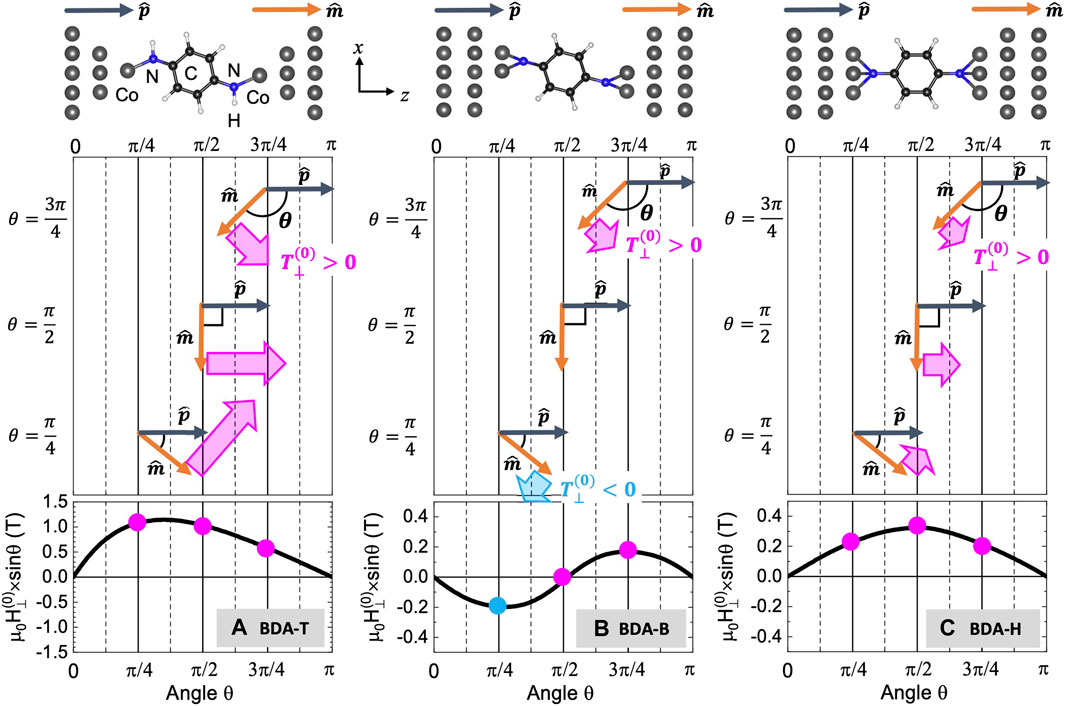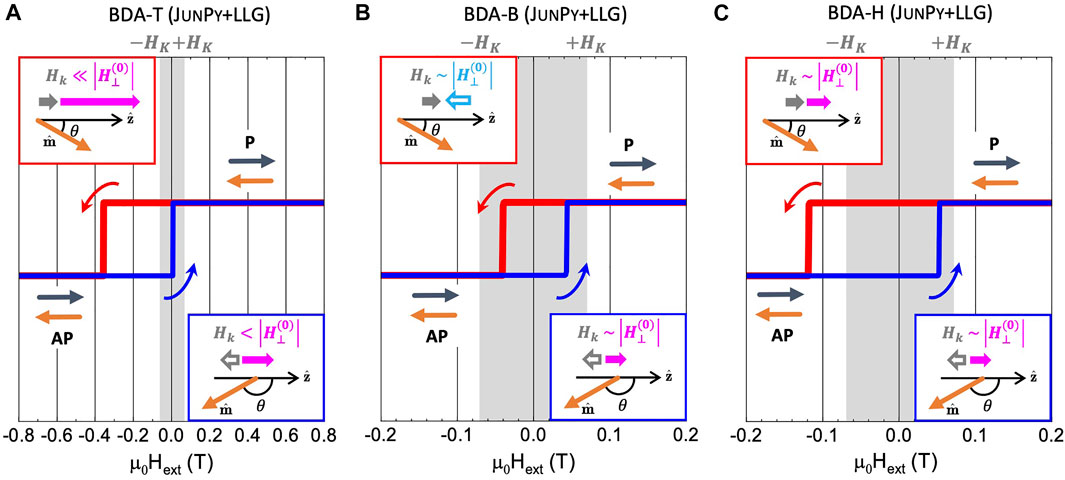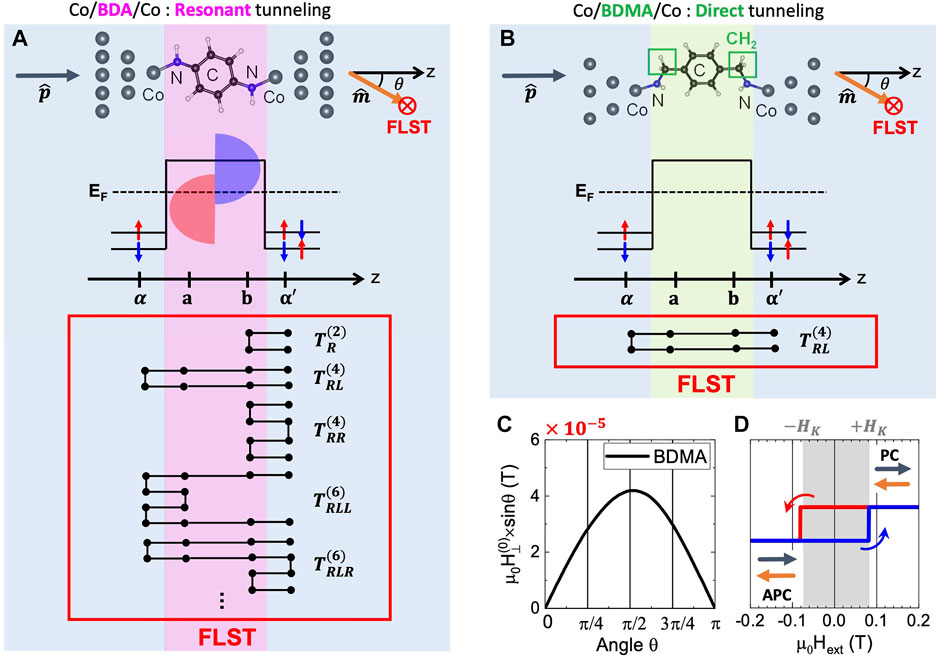
94% of researchers rate our articles as excellent or good
Learn more about the work of our research integrity team to safeguard the quality of each article we publish.
Find out more
ORIGINAL RESEARCH article
Front. Phys., 09 September 2022
Sec. Condensed Matter Physics
Volume 10 - 2022 | https://doi.org/10.3389/fphy.2022.967406
The molecular scale magnetic proximity effect is proposed in single-molecule magnetic junctions (SMMJs) consisting of a dissociated amine-ended 1,4-benzenediamine (BDA) molecule coupled to two ferromagnetic Co electrodes. Our self-developed JunPy + Landau-Lifshitz-Gilbert simulation combined with first-principles calculation is employed to investigate the role of contact geometry in the magnetotransport properties of SMMJs with the choice of top, bridge, and hollow contact sites. The strong spinterface effect gives rise to distinct angular dependence of equilibrium field-like spin torque (FLST), asymmetric magnetic hysteresis loop and tunable exchange bias. From the analytical derivation of nonequilibrium Keldysh formalism, we believe that a promising way forward is to activate the multi-reflection process via the so-called molecular spinterface that will allow us to conquer as-yet unexplored magnetotransport properties of organic-based spintronics.
Multi-toggling of magnetism in nanoscale magnetic heterostructures is significant for both fundamental and application in energy-efficient magnetic data storage, such as computer hard disks and magnetic random access memories (MRAMs). Among the hottest topics in contemporary spintronics, the spinterface [1–6] effect plays a crucial role to modulate the magnetic proximity effects via magnetic field, electric field, mechanical strain, and so on. Much effort has been devoted to solid-state magnetic devices, since the spin polarization and spin-orbit coupling (SOC) are decisive factors in spin transport and magnetic proximity [7–11], such as magnetic anisotropy, exchange bias (EB), and magnetic coercivity.
Electrical and spin switches across a single organic molecule connecting ferromagnetic electrodes are also burgeoning fields for possible applications in nano-spintronics devices [12–14], since chemical design offers various ways to incorporate spin degrees of freedom into a molecule to form the so-called molecular spintronics. Currently, most theoretical works [15–19] focus on the magnetoresistance and the spin-polarized transport in collinear magnetic configurations. The ability to calculate the noncollinear spin torque effect and spin dynamics of magnetic heterostructures remains difficult but important to include the complex structural, electronic, and magnetic properties at spinterfaces for nanoscale spintronics devices.
We introduce in Figure 1 the four steps of DFT + JunPy + LLG calculation procedure, including the density functional theory (DFT) calculation with our self-developed JunPy + LLG simulation, to investigate the magnetoelectric and magnetotransport properties of complex magnetic heterostructures, such as magnetic tunnel junctions (MTJs) [20] and single-molecule magnetic junctions (SMMJs) [21,22]. In this study, we propose the prototypical Co/1,4-benzenediamine (BDA)/Co SMMJs with three kinds of contact geometries for top (BDA-T), bridge (BDA-B), and hollow (BDA-H) contact sites of the N ion bonding to one, two, and three Co apex atoms, respectively. Since the hybridization between Co-d, N-py, and π-orbital of the phenyl ring preserve the spin-up pronounced resonance channel [23], the DFT + JunPy + LLG calculation reveals exchange bias toggling via the interplay between spinterface enhanced equilibrium field-like spin torque (FLST) and coercive field of Co electrode. We further use the nonequilibrium Keldysh formalism to clarify the crucial role of multi-reflection processes at interfaces in the non-sinusoidal angular dependence of equilibrium FLST, which may pave the way for unexplored magnetotransport properties of organic-based spintronics.

FIGURE 1. DFT + JunPy + LLG calculation procedure to investigate the magnetoelectric and magnetotransport properties of complex magnetic heterostructures, such as magnetic tunnel junctions (MTJs) [20] and single-molecule magnetic junctions (SMMJs) [21, 22].
The first step of DFT + JunPy + LLG calculation is to carry out the first-principles calculation including the complex charge transfer and spinterfacial effect via self-consistent process. In the top of Figures 2A–C, these amine-ended SMMJs are composed of a dissociated 1,4-benzenediamine (BDA) sandwiched by two Co hcp [0001] oriented semi-infinite nanowires. To prevent coupling between SMMJs, we set the lateral separation between two neighboring junctions as 7 Å in both x- and y-directions. The junction geometry is optimized by the Vienna Ab initio simulation package (VASP) [24–27] with DFT based generalized gradient approximation (GGA) in the Perdew, Burke, and Ernzerhof (PBE) [28] form. The lattice constant of Co nanowire is fixed at 2.5 Å, and the Co apex atoms and the central BDA molecule are fully relaxed by using the force criteria of 0.02 eV/Å, the cut-off energy of plane wave basis set as 700 eV, a force criterion of 0.02 eV/Å, the total energy difference for electronic steps as 10–5 eV, and the k-point sampling of Γ-point. Based on the Pearson’s principle of hard and soft acids and bases (HSAB) [29], the strong coupling between hard metal (Co) and hard base (N) in amine-ended SMMJs favors the covalent bonding between H-dissociated amine linker and Co adatom. This may provide variability in linker–electrode contact geometry, which is crucial but usually not easily controlled during the fabrication of real SMMJs especially for breaking junction techniques [13]. Here we adopt three possible contact geometries, i.e., top (T-III′), bridge (B-II), and hollow (H-III) contact sites proposed in Figure 1 of Ref. [23], as long as the hydrogen ion is dissociated to form a covalent bond between Co-d and N-px,y orbitals. On the one hand the N ion bonds to the central phenyl ring, and on the other hand the amine linker tends to dissociate one (two) H ion to form one (two/three) bonding with Co adatom in T (B/H) case to fulfill the octet rule. This thus gives rise to the shorter optimized Co-N bond length of 1.84 Å in both BDA-T and BDA-B cases but the longer one of 1.95 Å in BDA-H case. By using the optimized junction geometries, we next use the two-probe structure with DFT and non-equilibrium Green’s function (NEGF) formalism implemented in Nanodcal transport package [30–32] to investigate the spin-polarized transmission spectum and spinterface effect of SMMJs [23]. The double-ζ double-polarized basis set of local numerical orbitals are applied to all ions, the cut-off energy of real space grid density is 150 Hartree, and the k-point samplings are 1 × 1 × 100 and Γ point for semi-infinite Co electrode and central device, respectively.

FIGURE 2. [Top] Junction geometries [Middle] the DFT + JunPy calculated equilibrium FLST,
In the second and third steps, our self-developed JunPy package [20, 21, 33] has successfully combined the NEGF and spin torque theory to calculate the angular dependence of equilibrium FLST,
and σy is the y-component of Pauli matrices. Thus, the net FLST acting on the right (free) Co electrode is defined as
The last step of macrospin dynamics simulation is to apply the generalized Landau-Lifshitz-Gilbert (LLG) equation with equilibrium FLST component of spin torque [22, 35] as expressed in the form of
where γ is the gyromagnetic ratio, α is the Gilbert damping constant,
In the bottom of Figures 2A–C, we demonstrate the angular dependence of DFT + JunPy calculated equilibrium FLST fields,

FIGURE 3. The JunPy + LLG calculated magnetic hysteresis curves (mz-H) for (A) BDA-T (top-site), (B) BDA-B (bridge-site), and (C) BDA-H (hollow-site) cases of amine-ended Co/BDA/Co SMMJs at zero temperature. The insets are the schematics of
For the BDA-T case in Figure 2A, its
Unlike BDA-T case, the smaller magnitude with nearly sin 2θ angular dependence of
To further demonstrate the validity of our self-developed LLG simulation, we carry out the well-known OOMMF software [38] with the extension of SpinXferEvolve, but this extension simply uses default sinusoidal angular dependence of FLST in MTJs. Therefore, we revise it to include the user-defined angular dependence of FLST by fitting to our DFT + JunPy calculation in Co/BDA/Co SMMJs with three kinds of contact geometries as presented in Figures 2A–C. It is clear to find the excellent agreement between OOMMF simulation in Figures 4A–C and our own LLG calculation in Figures 4A–C.

FIGURE 4. The JunPy + OOMMF calculated magnetic hysteresis curves (mz‐H) for (A) BDA‐T (top‐site), (B) BDA‐B (bridge‐site), and (C) BDA‐H (hollow‐site) cases of amine‐ended Co/BDA/Co SMMJs at zero temperature.
Finally, we turn to investigate the underlying mechanism of non-sinusoidal angular dependence of equilibrium FLST field by using the NEGF method to derive analytical formalism of equilibrium FLST

FIGURE 5. [Top] Junction geometries, [Middle] schematic of energy profile, and [Bottom] schematic of multi-reflection paths of
The net equilibrium FLST acting on the right (free) Co electrode can be defined by the one-dimensional tight-binding model with non-equilibrium Keldysh formalism [39],
where b and α′ denote the last site of barrier and first site of right Co electrode, respectively, and t is the coupling between barrier and the two Co electrodes. In consideration of multi-reflection process between two Co leads, the
Note that
where
By substituting Eqs 5, 6 into Eq. 3, we can derive the corresponding
We finally discuss the angular dependence of equilibrium FLST for noncollinear Co/BDA/Co(θ) SMMJ in Figure 5A. To simulate its strong spin-up dominated π-resonant tunneling, both
to represent the t2N-th order of equilibrium FLST including the Nth multi-reflection processes of M and (N − M) times at left Co/N and right N/Co interfaces, respectively, and a0 and an’s are real numbers. Notably, this allows us to modulate the spinterface induced non-sinusoidal angular dependence of equilibrium FLST fields via the contact geometry in BDA-based SMMJs as shown in Figures 2A–C.
It is interesting to recall that BDA-H case exhibits pronounced π-resonant spin-up transmission near Fermi energy even though its Co-N bond length (1.95 Å) is relatively larger than those of BDA-T (1.84 Å) and BDA-B (1.84 Å) cases. This gives rise to a weaker spinterface effect of BDA-H case that still can assist the enhancement of equilibrium FLST, i.e., |H(0)|∼ HK, but the larger Co-N bond length significantly weakens those contributions from multi-reflection process and hence in turn preserves the sinusoidal angular dependence of
We summarize the four steps of DFT + JunPy + LLG calculation, which successfully resolve computational difficulties in spin torque, magnetotransport and magnetic proximity for complex magnetic heterojunctions with noncollinear magnetic configurations. Here we propose three types of dissociated amine-ended Co/BDA/Co SMMJs with top, bridge, and hollow contact sites together with strong equilibrium FLST fields, i.e.,
The original contributions presented in the study are included in the article, further inquiries can be directed to the corresponding author.
Y-HT conceived the study and carried out the DFT + JunPy + LLG calculation. Y-HT and Y-CC carry out the analytical derivation and the macrospin dynamics simulation. B-HH developed JunPy + LLG code. All authors discussed the results and wrote the manuscript.
This work is supported by the Ministry of Science and Technology (MOST 107-2633-M-008-004- and 108-2628-M-008-004-MY3) and the National Center for Theoretical Sciences (NCTS).
We thank Yu-Sheng Lin to support the analytical derivation of spin torque effect via resonant tunneling. We thank to National Center for High-performance Computing (NCHC) of National Applied Research Laboratories (NARLabs) in Taiwan for providing computational and storage resources.
The authors declare that the research was conducted in the absence of any commercial or financial relationships that could be construed as a potential conflict of interest.
All claims expressed in this article are solely those of the authors and do not necessarily represent those of their affiliated organizations, or those of the publisher, the editors and the reviewers. Any product that may be evaluated in this article, or claim that may be made by its manufacturer, is not guaranteed or endorsed by the publisher.
4. Dieny B, Chshiev M. Perpendicular magnetic anisotropy at transition metal/oxide interfaces and applications. Rev Mod Phys (2017) 89:025008. doi:10.1103/RevModPhys.89.025008
5. Cinchetti M, Dediu VA, Hueso LE. Activating the molecular spinterface. Nat Mater (2017) 16:507–15. doi:10.1038/nmat4902
6. Go D, Freimuth F, Hanke J-P, Xue F, Gomonay O, Lee K-J, et al. Theory of current-induced angular momentum transfer dynamics in spin-orbit coupled systems. Phys Rev Res (2020) 2:033401. doi:10.1103/PhysRevResearch.2.033401
7. Fan Y, Smith KJ, Lüpke G, Hanbicki AT, Goswami R, Li CH, et al. Exchange bias of the interface spin system at the Fe/MgO interface. Nat Nanotechnol (2013) 8:438–44. doi:10.1038/nnano.2013.94
8. Manna PK, Yusuf SM. Two interface effects: Exchange bias and magnetic proximity. Phys Rep (2014) 535:61–99. doi:10.1016/j.physrep.2013.10.002
9. Liang X, Deng L, Huang F, Tang T, Wang C, Zhu Y, et al. The magnetic proximity effect and electrical field tunable valley degeneracy in MoS2/EuS van der waals heterojunctions. NANOSCALE (2017) 9:9502–9. doi:10.1039/c7nr03317f
10. Lin P-H, Yang B-Y, Tsai M-H, Chen P-C, Huang K-F, Lin H-H, et al. Manipulating exchange bias by spin–orbit torque. Nat Mater (2019) 18:335–41. doi:10.1038/s41563-019-0289-4
11. Srivastava PK, Hassan Y, Ahn H, Kang B, Jung S-G, Gebredingle Y, et al. Exchange bias effect in ferro-/antiferromagnetic van der waals heterostructures. Nano Lett (2020) 20:3978–85. doi:10.1021/acs.nanolett.0c01176
12. Aragonès AC, Medina E, Ferrer-Huerta M, Gimeno N, Teixidó M, Palma JL, et al. Measuring the spin-polarization power of a single chiral molecule. Small (2017) 13:1602519. doi:10.1002/smll.201602519
13. Gehring P, Thijssen JM, van der Zant HSJ. Single-molecule quantum-transport phenomena in break junctions. Nat Rev Phys (2019) 1:381–96. doi:10.1038/s42254-019-0055-1
14. Ke G, Duan C, Huang F, Guo X. Electrical and spin switches in single-molecule junctions. InfoMat (2020) 2:92–112. doi:10.1002/inf2.12068
15. Liu D, Hu Y, Guo H, Han XF. Magnetic proximity effect at the molecular scale: First-principles calculations. Phys Rev B (2008) 78:193307. doi:10.1103/PhysRevB.78.193307
16. Mandal S, Pati R. What determines the sign reversal of magnetoresistance in a molecular tunnel junction? ACS Nano (2012) 6:3580–8. doi:10.1021/nn3006569
17. Smogunov A, Dappe YJ. Symmetry-derived half-metallicity in atomic and molecular junctions. Nano Lett (2015) 15:3552–6. doi:10.1021/acs.nanolett.5b01004
18. Li D, Banerjee R, Mondal S, Maliyov I, Romanova M, Dappe YJ, et al. Symmetry aspects of spin filtering in molecular junctions: Hybridization and quantum interference effects. Phys Rev B (2019) 99:115403. doi:10.1103/PhysRevB.99.115403
19. Zhang L-M, Miao Y-Y, Cao Z-P, Qiu S, Zhang G-P, Ren J-F, et al. Bias-induced reconstruction of hybrid interface states in magnetic molecular junctions. Chin Phys B (2022) 31:057303. doi:10.1088/1674-1056/ac3caf
20. Huang B-H, Chao C-C, Tang Y-H. Thickness dependence of spin torque effect in Fe/MgO/Fe magnetic tunnel junction: Implementation of divide-and-conquer with first-principles calculation. AIP Adv (2021) 11:015036. doi:10.1063/9.0000117
21. Tang Y-H, Huang B-H. Manipulation of giant field-like spin torque in amine-ended single-molecule magnetic junctions. J Phys Chem C (2018) 122:20500–5. doi:10.1021/acs.jpcc.8b03772
22. Tang Y-H, Huang B-H. Underlying mechanism for exchange bias in single-molecule magnetic junctions. Phys Rev Res (2021) 3:033264. doi:10.1103/PhysRevResearch.3.033264
23. Chiang K-R, Tang Y-H. Effect of contact geometry on spin transport in amine-ended single-molecule magnetic junctions. ACS Omega (2021) 6:19386–91. doi:10.1021/acsomega.1c00930
24. Kresse G, Hafner J. Ab initio molecular dynamics for liquid metals. Phys Rev B (1993) 47:558–61. doi:10.1103/PhysRevB.47.558
25. Kresse G, Hafner J. Ab initio molecular dynamics for open-shell transition metals. Phys Rev B (1993) 48:13115–8. doi:10.1103/PhysRevB.48.13115
26. Kresse G, Hafner J. Ab initio molecular-dynamics simulation of the liquid-metal–amorphous-semiconductor transition in germanium. Phys Rev B (1994) 49:14251–69. doi:10.1103/PhysRevB.49.14251
27. Kresse G, Furthmuller J. Efficiency of ab-initio total energy calculations for metals and semiconductors using a plane-wave basis set. Comput Mater Sci (1996) 6:15–50. doi:10.1016/0927-0256(96)00008-0
28. Perdew JP, Burke K, Ernzerhof M. Generalized gradient approximation made simple. Phys Rev Lett (1996) 77:3865–8. doi:10.1103/PhysRevLett.77.3865
29. Pearson RG. Hard and soft acids and bases. J Am Chem Soc (1963) 85:3533–9. doi:10.1021/ja00905a001
30. Waldron D, Liu L, Guo H. Ab initio simulation of magnetic tunnel junctions. Nanotechnology (2007) 18:424026. doi:10.1088/0957-4484/18/42/424026
31. Taylor J, Guo H, Wang J. Ab initio modeling of quantum transport properties of molecular electronic devices. Phys Rev B (2001) 63:245407. doi:10.1103/PhysRevB.63.245407
32. Ke Y, Xia K, Guo H. Disorder scattering in magnetic tunnel junctions: Theory of nonequilibrium vertex correction. Phys Rev Lett (2008) 100:166805. doi:10.1103/PhysRevLett.100.166805
33.[Dataset] Huang B-H, Tang Y-H. The detailed information of our newly developed JunPy package can be found at (2018). Available at: https://labstt.phy.ncu.edu.tw/junpy.
34. Stiles MD, Zangwill A. Anatomy of spin-transfer torque. Phys Rev B (2002) 66:014407. doi:10.1103/PhysRevB.66.014407
35. de Sousa DJP, Haney PM, Zhang DL, Wang JP, Low T. Bidirectional switching assisted by interlayer exchange coupling in asymmetric magnetic tunnel junctions. Phys Rev B (2020) 101:081404. doi:10.1103/PhysRevB.101.081404
36. Xiao J, Zangwill A, Stiles MD. Macrospin models of spin transfer dynamics. Phys Rev B (2005) 72:014446. doi:10.1103/PhysRevB.72.014446
37. Tang Y-H, Kioussis N, Kalitsov A, Butler WH, Car R. Controlling the nonequilibrium interlayer exchange coupling in asymmetric magnetic tunnel junctions. Phys Rev Lett (2009) 103:057206. doi:10.1103/PhysRevLett.103.057206
38.[Dataset] Donahue J, Porter DG. OOMMF user’s guide version 1.0. Gaithersburg, MD: National Institute of Standards and Technology (1999).
Keywords: exchange bias, field-like spin torque, contact geometry, first-principles, magnetotransport, spin dynamics, single-molecule magnetic junction
Citation: Tang Y-H, Chuang Y-C and Huang B-H (2022) Exchange bias toggling in amine-ended single-molecule magnetic junctions by contact geometry. Front. Phys. 10:967406. doi: 10.3389/fphy.2022.967406
Received: 12 June 2022; Accepted: 25 July 2022;
Published: 09 September 2022.
Edited by:
Dongzhe Li, UPR8011 Centre d’Élaboration de Matériaux et d’Etudes Structurales (CEMES), FranceReviewed by:
Alexey Kartsev, Russian Academy of Sciences (RAS), RussiaCopyright © 2022 Tang, Chuang and Huang . This is an open-access article distributed under the terms of the Creative Commons Attribution License (CC BY). The use, distribution or reproduction in other forums is permitted, provided the original author(s) and the copyright owner(s) are credited and that the original publication in this journal is cited, in accordance with accepted academic practice. No use, distribution or reproduction is permitted which does not comply with these terms.
*Correspondence: Yu-Hui Tang, eWh0YW5nQGNjLm5jdS5lZHUudHc=
Disclaimer: All claims expressed in this article are solely those of the authors and do not necessarily represent those of their affiliated organizations, or those of the publisher, the editors and the reviewers. Any product that may be evaluated in this article or claim that may be made by its manufacturer is not guaranteed or endorsed by the publisher.
Research integrity at Frontiers

Learn more about the work of our research integrity team to safeguard the quality of each article we publish.